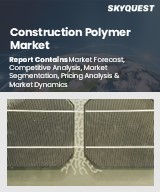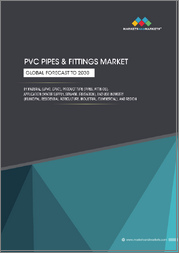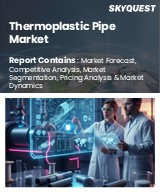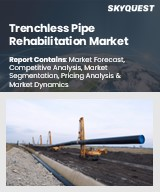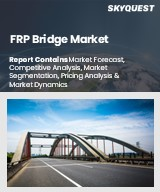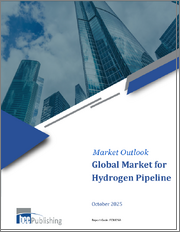
|
시장보고서
상품코드
1423710
트렌치리스 파이프 갱생 시장 예측(-2030년) : 직경 유형별, 용도별, 지역별 세계 분석Trenchless Pipe Rehabilitation Market Forecasts to 2030 - Global Analysis By Diameter Type (< 18 Inch Pipes, >36 Inch Pipes and 18-36 Inch Pipes), Application and By Geography |
||||||
Stratistics MRC에 따르면 세계의 트렌치리스 파이프 갱생 시장은 2023년에 44억 달러를 차지하고 예측 기간 중 CAGR 7.8%로 성장하며, 2030년에는 75억 달러에 달할 전망입니다.
트렌치리스 파이프 갱생은 대규모 굴착 없이 지하 파이프를 수리하거나 교체하기 위해 채택된 일련의 첨단 기술을 말합니다. 이 혁신적인 접근 방식은 주변 환경과 인프라에 미치는 영향을 최소화하고 기존 방식에 비해 비용 효율적이고 효율적인 솔루션을 제공합니다. 이 프로세스에는 일반적으로 CIPP(Cured-in-place pipe) 라이닝, 파이프 버스트, 슬립 라이닝 등 다양한 기술이 사용됩니다. 예를 들어 CIPP 라이닝은 수지로 코팅된 플렉서블 튜브를 손상된 파이프에 삽입하고 제자리에서 경화시켜 기존 파이프라인 내에 내구성이 뛰어나고 이음새가 없는 새로운 파이프라인을 형성합니다.
미국 상수도협회에 따르면 향후 25년간 노후화된 상수도 시설을 보수하고 인구 증가에 대응할 수 있는 유용성을 확보하기 위해 1조 달러 이상의 투자가 필요할 것으로 추산됩니다.
환경에 대한 인식이 높아짐
사회가 생태계에 미치는 영향에 대한 인식이 높아짐에 따라 지하 파이프라인을 보수하거나 교체하는 전통적인 굴착 공법은 파괴적이고 환경 파괴적인 특성으로 인해 점점 더 많은 조사를 받고 있으며, CIPP(현장 경화 파이프) 라이닝 및 파이프 파열과 같은 트렌치리스 기술이 점점 더 많은 관심을 받고 있습니다, 지표면 파괴를 최소화하고, 경관을 보호하며, 건설 활동에 따른 전체 환경 발자국을 줄임으로써 지속가능한 대안을 제시합니다. 또한 트렌치리스 파이프 리허빌리테이션의 환경 친화적 특성은 엄격한 환경 규제에 부합하고 정부 기관과 지역 사회를 포함한 이해관계자들 사이에서 긍정적인 인식을 형성하고 있습니다.
높은 초기 비용
트렌치리스 공법은 노동력, 굴착 및 복구 비용 절감을 통해 장기적으로 비용을 절감할 수 있지만, 특수 장비, 고급 자재 및 숙련된 인력에 대한 초기 투자비용이 상당합니다. 이러한 재정적 장벽은 이해관계자, 특히 예산이 제한된 소규모 지자체나 조직이 트렌치리스 솔루션을 도입하는 것을 주저하게 만드는 요인으로 작용할 수 있습니다. 자본 집약적인 장비의 필요성과 전문 기술 인력 양성 관련 비용으로 인해 트렌치리스 리노베이션이 기존 굴착 공법에 비해 재정적으로 더 어려운 선택이라는 인식이 있습니다.
기술의 발전
재료, 로봇 공학 및 검사 툴의 혁신은 트렌치리스 기술에 혁명을 일으켜 보다 정확하고 비용 효율적인 솔루션을 가능하게 했으며, CIPP(현장 경화 파이프) 라이닝용 내구성 수지와 같은 첨단 재료는 복구된 파이프라인의 수명과 구조적 무결성에 기여하고 있습니다.에 기여하고 있습니다. 로봇 공학은 장비를 원격으로 조작하거나 좁은 공간에서 복잡한 작업을 수행하는 데 중요한 역할을 하여 작업의 정확성과 안전성을 높입니다. 또한 고해상도 카메라 및 센서와 같은 첨단 검사 툴을 통해 파이프라인의 상태를 철저하게 평가할 수 있습니다.
규제 인허가의 과제
트렌치리스 기술을 도입하려면 지하 인프라 프로젝트에 적용되는 다양하고 엄격한 규정을 준수해야 합니다. 필요한 인허가를 취득하는 것은 지역과 당국에 따라 다르며, 장기간에 걸친 복잡한 절차가 될 수 있습니다. 규제 프레임워크를 이해하고, 인허가를 취득하고, 환경 및 안전 기준을 준수하기 위한 복잡한 작업은 프로젝트 일정을 지연시키고 전체 비용을 증가시키는 요인으로 작용할 수 있습니다. 그러나 다양한 규제 요건이 표준화의 걸림돌로 작용하고 있으며, 업계 이해관계자들은 다양한 관할권의 구체적인 요구사항을 이해하고 충족시키기 위해 상당한 시간과 자원을 투자해야 합니다.
COVID-19의 영향 :
초기에는 프로젝트 일정과 공급망에 혼란이 발생하여 트렌치리스 기술 도입에 영향을 미쳤습니다. 공사 제한, 노동력 부족, 물류 문제로 인해 복구 프로젝트가 원활하게 진행되지 못했습니다. 그러나 이번 팬데믹은 탄력적이고 효율적인 인프라의 중요성을 부각시켰고, 정부와 업계가 노후화된 파이프라인을 처리할 수 있는 혁신적인 방법을 모색하는 과정에서 트렌치리스 솔루션에 대한 관심이 높아질 수 있습니다. 또한 팬데믹 기간 중 원격 조작이 가능하고 노동 집약적이지 않은 기술에 대한 필요성이 주목받았으며, 이는 많은 트렌치리스 공법의 특징과 일치합니다.
예측 기간 중 18-36인치 파이프 분야가 가장 클 것으로 예상
18-36인치 파이프 부문은 시장에서 큰 호황을 누리고 있습니다. 이 특정 파이프 크기 범위는 일반적으로 상수도, 하수도 및 산업용 파이프라인을 포함한 중요한 인프라 네트워크에서 흔히 볼 수 있습니다. 도시화와 산업 활동이 증가함에 따라 이러한 대구경 파이프에 대한 효율적이고 덜 파괴적인 재건 방법에 대한 수요가 급증하고 있으며, CIPP(묻힌 파이프) 라이닝 및 파이프 버스트와 같은 트렌치리스 기술은 18-36인치 파이프의 수리 및 유지보수에 적합한 솔루션을 제공합니다. 솔루션을 제공합니다. 이러한 공법은 구조적 문제를 해결하고, 환경에 미치는 영향을 줄이며, 다운타임을 최소화할 수 있으므로 대규모 파이프라인 네트워크를 관리하는 지자체와 산업계에 점점 더 매력적으로 다가오고 있습니다.
예측 기간 중 폐수관 분야가 가장 높은 CAGR을 보일 것으로 예상
지속가능한 폐수 관리에 대한 전 세계적인 관심 증가로 폐수관 분야는 수익성 높은 성장세를 보이고 있습니다. 이러한 기술을 통해 기존 굴착 공법처럼 파괴적이고 환경에 큰 영향을 주지 않고도 폐수관을 효율적으로 보수 및 개조할 수 있습니다. 폐수관 분야에서 트렌치리스 솔루션의 채택은 노후화된 시스템을 해결하고, 누수를 줄이며, 전반적인 운영 효율성을 높이기 위한 시급한 필요성에 따라 증가하고 있습니다. 또한 정부, 지자체 및 폐수 처리 당국은 폐수 파이프라인의 수명을 연장하고 환경에 미치는 영향을 최소화하며 환경적으로 지속가능한 방식으로 폐수를 운반하기 위해 트렌치리스 리노베이션을 채택하는 추세가 증가하고 있습니다.
가장 큰 점유율을 차지하는 지역
추정 기간 중 아시아태평양이 가장 큰 시장 점유율을 차지할 것으로 예상됩니다. 급속한 도시화, 인구 증가, 노후화된 유틸리티 네트워크의 업그레이드 필요성으로 인해 효율적이고 중단 없는 파이프라인 재활 솔루션에 대한 수요가 증가하고 있습니다. 중국과 인도와 같은 국가의 정부는 상하수도 인프라 현대화에 많은 투자를 하고 있으며, 이는 트렌치리스 기술 도입에 적합한 환경을 조성하고 있습니다. 또한 이 지역은 지속가능한 개발에 중점을 두고 있으며, 트렌치리스 공법이 환경에 미치는 영향을 줄이고 인구 밀집도가 높은 도시 지역에 미치는 영향을 최소화할 수 있다는 점도 일치합니다.
CAGR이 가장 높은 지역 :
유럽은 예측 기간 중 유리한 성장세를 보이고 있습니다. 유럽 정부는 기존 굴착 공법이 환경에 미치는 영향을 인식하고 환경 친화적인 솔루션을 강조하는 엄격한 기준을 도입하고 있습니다. 트렌치리스 파이프 리파이닝은 지표면 파괴를 최소화하고 탄소 배출량을 줄이기 때문에 이러한 규제 프레임워크에 잘 부합합니다. 유럽연합(EU)은 수질 보전, 환경 보호 및 전반적인 환경의 지속가능성을 중요시하기 때문에 지하 파이프라인의 보수 및 개선에 트렌치리스 기술을 점점 더 많이 채택하고 있습니다.
무료 맞춤형 서비스 :
이 보고서를 구독하는 고객은 다음과 같은 무료 맞춤화 옵션 중 하나를 사용할 수 있습니다. :
- 기업 개요
- 추가 시장 기업의 종합적인 프로파일링(최대 3사)
- 주요 기업의 SWOT 분석(최대 3사)
- 지역 세분화
- 고객의 관심에 따른 주요 국가별 시장 추정치, 예측, CAGR(주: 타당성 확인에 따라 다름)
- 경쟁사 벤치마킹
- 제품 포트폴리오, 지역적 입지, 전략적 제휴를 기반으로 한 주요 기업 벤치마킹
목차
제1장 주요 요약
제2장 서문
- 개요
- 이해관계자
- 조사 범위
- 조사 방법
- 데이터 마이닝
- 데이터 분석
- 데이터 검증
- 조사 어프로치
- 조사 소스
- 1차 조사 소스
- 2차 조사 소스
- 전제조건
제3장 시장 동향 분석
- 촉진요인
- 억제요인
- 기회
- 위협
- 애플리케이션 분석
- 신흥 시장
- 신종 코로나바이러스 감염증(COVID-19)의 영향
제4장 Porter's Five Forces 분석
- 공급 기업의 교섭력
- 구매자의 교섭력
- 대체품의 위협
- 신규 진출업체의 위협
- 경쟁 기업간 경쟁 관계
제5장 세계의 트렌치리스 파이프 갱생 시장 : 직경 유형별
- 18인치 미만 파이프
- 36인치 이상 파이프
- 18-36인치 파이프
제6장 세계의 트렌치리스 파이프 갱생 시장 : 용도별
- 배수관
- 수도 본관
- 산업용 파이프라인
- 기타 용도
제7장 세계의 트렌치리스 파이프 갱생 시장 : 지역별
- 북미
- 미국
- 캐나다
- 멕시코
- 유럽
- 독일
- 영국
- 이탈리아
- 프랑스
- 스페인
- 기타 유럽
- 아시아태평양
- 일본
- 중국
- 인도
- 호주
- 뉴질랜드
- 한국
- 기타 아시아태평양
- 남미
- 아르헨티나
- 브라질
- 칠레
- 기타 남미
- 중동 및 아프리카
- 사우디아라비아
- 아랍에미리트
- 카타르
- 남아프리카공화국
- 기타 중동 및 아프리카
제8장 주요 발전
- 계약, 파트너십, 협업, 합병사업
- 인수합병
- 신제품의 발매
- 사업 확대
- 기타 주요 전략
제9장 기업 개요
- Aegion Corporation
- Amex Sanivar
- Ashimori Industry
- Granite Construction
- Ham Baker Adams Ltd
- Kurita Water Industries Ltd
- NordiTube Technologies
- Per Aarsleff A/S
- Deep Trekker Inc
- RSM Lining Supplies Global Ltd
- SAERTEX MultiCom
- SAK Construction
- Waterline Renewal Technologies
According to Stratistics MRC, the Global Trenchless Pipe Rehabilitation Market is accounted for $4.4 billion in 2023 and is expected to reach $7.5 billion by 2030 growing at a CAGR of 7.8% during the forecast period. Trenchless pipe rehabilitation refers to a set of advanced techniques employed to repair or replace underground pipes without the need for extensive excavation. This innovative approach minimizes disruption to the surrounding environment and infrastructure, offering a more cost-effective and efficient solution compared to traditional methods. The process typically involves the use of various technologies such as cured-in-place pipe (CIPP) lining, pipe bursting, and slip lining. CIPP lining, for instance, involves inserting a resin-coated flexible tube into the damaged pipe, which is then cured in place, creating a durable and seamless new pipeline within the existing one.
According to the American Water Works Association, it has been estimated that >US$ 1 trillion of investment is required over the next 25 years to repair the degrading water services as well as to ensure their usefulness to serve the growing population of the nation.
Market Dynamics:
Driver:
Increasing environmental awareness
As societies become more conscientious about ecological impacts, traditional open-cut methods for repairing and replacing underground pipelines are increasingly scrutinized for their disruptive and environmentally damaging characteristics. Trenchless technologies, such as cured-in-place pipe (CIPP) lining and pipe bursting, offer a sustainable alternative by minimizing surface disruption, preserving landscapes, and reducing overall environmental footprints associated with construction activities. Furthermore, the eco-friendly nature of trenchless pipe rehabilitation aligns with stringent environmental regulations and fosters a positive perception among stakeholders, including government bodies and communities.
Restraint:
High initial costs
While these methods offer long-term cost savings through reduced labor, excavation, and restoration expenses, the upfront investment required for specialized equipment, advanced materials, and skilled labor can be substantial. This financial barrier may deter some stakeholders, particularly smaller municipalities or organizations with budget constraints, from embracing trenchless solutions. The need for capital-intensive equipment and the expenses associated with training personnel in specialized techniques contribute to the perception that trenchless rehabilitation is a more financially demanding option compared to traditional open-cut methods.
Opportunity:
Technological advancements
Innovations in materials, robotics, and inspection tools have revolutionized trenchless technologies, allowing for more precise and cost-effective solutions. Advanced materials, such as durable resins for cured-in-place pipe (CIPP) lining, contribute to the longevity and structural integrity of rehabilitated pipelines. Robotics play a crucial role in remotely operating equipment and performing intricate tasks in confined spaces, increasing the accuracy and safety of operations. Additionally, sophisticated inspection tools, including high-resolution cameras and sensors, enable thorough assessments of pipeline conditions.
Threat:
Regulatory approval challenges
The implementation of trenchless technologies requires adherence to diverse and often stringent regulations governing underground infrastructure projects. Obtaining necessary approvals can be a protracted and complex process, varying across regions and authorities. The intricacies of navigating regulatory frameworks, obtaining permits, and ensuring compliance with environmental and safety standards contribute to delays in project timelines and increase overall costs. However, the diverse nature of regulatory requirements poses a hurdle for standardization, making it essential for industry stakeholders to invest considerable time and resources in understanding and satisfying the specific demands of different jurisdictions.
Covid-19 Impact:
The initial phase witnessed disruptions in project timelines and supply chains, impacting the implementation of trenchless technologies. Construction restrictions, labor shortages, and logistical issues hindered the seamless execution of rehabilitation projects. However, the pandemic also underscored the importance of resilient and efficient infrastructure, potentially driving increased interest in trenchless solutions as governments and industries seek innovative ways to address aging pipelines. Furthermore, the need for remote-operable and less labor-intensive technologies gained prominence during the pandemic, aligning with the features of many trenchless methods.
The 18-36 Inch Pipes segment is expected to be the largest during the forecast period
The 18-36 inch pipes segment is experiencing a substantial boom in the market. This particular pipe size range is commonly found in crucial infrastructure networks, including water supply, sewer, and industrial pipelines. As urbanization and industrial activities intensify, the demand for efficient and minimally disruptive rehabilitation methods for these larger-diameter pipes has surged. Trenchless technologies, such as cured-in-place pipe (CIPP) lining and pipe bursting, offer tailored solutions for the repair and maintenance of 18-36 inch pipes. The ability of these methods to address structural issues, reduce environmental impact, and minimize downtime makes them increasingly attractive to municipalities and industries managing extensive pipeline networks.
The Wastewater Pipes segment is expected to have the highest CAGR during the forecast period
The Wastewater Pipes segment is witnessing a profitable growth in the market due to the escalating global focus on sustainable wastewater management. These technologies enable efficient repair and renovation of wastewater pipes without the disruptive and environmentally impactful aspects of traditional open-cut methods. The Wastewater Pipes segment is witnessing increased adoption of trenchless solutions, driven by the pressing need to address deteriorating systems, reduce leaks, and enhance overall operational efficiency. In addition, governments, municipalities, and wastewater treatment authorities are increasingly turning to trenchless rehabilitation to extend the lifespan of their wastewater pipelines, minimize environmental impact, and ensure the reliable conveyance of wastewater in an environmentally sustainable manner.
Region with largest share:
Asia Pacific region commanded the largest share of the market throughout the extrapolated period. Rapid urbanization, expanding populations, and the need to upgrade aging utility networks have spurred demand for efficient and non-disruptive pipeline rehabilitation solutions. Governments in countries like China and India are investing heavily in modernizing water and wastewater infrastructure, creating a conducive environment for the adoption of trenchless technologies. Moreover, the region's focus on sustainable development aligns with trenchless methods' ability to reduce environmental impact and minimize disruption to densely populated urban areas.
Region with highest CAGR:
Europe region is experiencing lucrative growth throughout the projected period. European governments, recognizing the environmental impact of traditional excavation methods, have implemented strict standards emphasizing eco-friendly solutions. Trenchless pipe rehabilitation, with its minimal surface disruption and reduced carbon footprint, aligns well with these regulatory frameworks. The European Union's emphasis on water quality, conservation, and overall environmental sustainability has led to increased adoption of trenchless technologies for repairing and upgrading underground pipelines.
Key players in the market
Some of the key players in Trenchless Pipe Rehabilitation market include Aegion Corporation, Amex Sanivar, Ashimori Industry, Granite Construction, Ham Baker Adams Ltd, Kurita Water Industries Ltd, NordiTube Technologies, Per Aarsleff A/S, Deep Trekker Inc, RSM Lining Supplies Global Ltd, SAERTEX MultiCom, SAK Construction and Waterline Renewal Technologies.
Key Developments:
In February 2023, The Vortex Companies LLC, a leading player in advanced trenchless water and sewer technologies and infrastructure renewal services, launched its latest, inclusive UV Cured-in Place-Pipe systems solutions portfolio.
In October 2022, Insituform offers Harrisburg, Pennsylvania, Community wastewater rehabilitation solutions. This project will be concluded in various stages. Approximately three miles of interceptor sewer will be repaired by a trenchless process called cured-in-place pipe repair. This process is different from the conventional process as this method utilizes no-dig technology to repair old-fashioned sewer pipes.
In August 2022, Western Australia's Water Corporation undertook a project to renew old water pipes across Perth as part of the Pipes for Perth program. It rehabilitates around 700 m of outdated water pipelines in Kings Park between Bellevue Terrace and Mount Eliza Reservoir.
Diameter Types Covered:
- < 18 Inch Pipes
- >36 Inch Pipes
- 18-36 Inch Pipes
Applications Covered:
- Wastewater Pipes
- Water Main Pipes
- Industrial Pipelines
- Other Applications
Regions Covered:
- North America
- US
- Canada
- Mexico
- Europe
- Germany
- UK
- Italy
- France
- Spain
- Rest of Europe
- Asia Pacific
- Japan
- China
- India
- Australia
- New Zealand
- South Korea
- Rest of Asia Pacific
- South America
- Argentina
- Brazil
- Chile
- Rest of South America
- Middle East & Africa
- Saudi Arabia
- UAE
- Qatar
- South Africa
- Rest of Middle East & Africa
What our report offers:
- Market share assessments for the regional and country-level segments
- Strategic recommendations for the new entrants
- Covers Market data for the years 2021, 2022, 2023, 2026, and 2030
- Market Trends (Drivers, Constraints, Opportunities, Threats, Challenges, Investment Opportunities, and recommendations)
- Strategic recommendations in key business segments based on the market estimations
- Competitive landscaping mapping the key common trends
- Company profiling with detailed strategies, financials, and recent developments
- Supply chain trends mapping the latest technological advancements
Free Customization Offerings:
All the customers of this report will be entitled to receive one of the following free customization options:
- Company Profiling
- Comprehensive profiling of additional market players (up to 3)
- SWOT Analysis of key players (up to 3)
- Regional Segmentation
- Market estimations, Forecasts and CAGR of any prominent country as per the client's interest (Note: Depends on feasibility check)
- Competitive Benchmarking
- Benchmarking of key players based on product portfolio, geographical presence, and strategic alliances
Table of Contents
1 Executive Summary
2 Preface
- 2.1 Abstract
- 2.2 Stake Holders
- 2.3 Research Scope
- 2.4 Research Methodology
- 2.4.1 Data Mining
- 2.4.2 Data Analysis
- 2.4.3 Data Validation
- 2.4.4 Research Approach
- 2.5 Research Sources
- 2.5.1 Primary Research Sources
- 2.5.2 Secondary Research Sources
- 2.5.3 Assumptions
3 Market Trend Analysis
- 3.1 Introduction
- 3.2 Drivers
- 3.3 Restraints
- 3.4 Opportunities
- 3.5 Threats
- 3.6 Application Analysis
- 3.7 Emerging Markets
- 3.8 Impact of Covid-19
4 Porters Five Force Analysis
- 4.1 Bargaining power of suppliers
- 4.2 Bargaining power of buyers
- 4.3 Threat of substitutes
- 4.4 Threat of new entrants
- 4.5 Competitive rivalry
5 Global Trenchless Pipe Rehabilitation Market, By Diameter Type
- 5.1 Introduction
- 5.2 < 18 Inch Pipes
- 5.3 >36 Inch Pipes
- 5.4 18-36 Inch Pipes
6 Global Trenchless Pipe Rehabilitation Market, By Application
- 6.1 Introduction
- 6.2 Wastewater Pipes
- 6.3 Water Main Pipes
- 6.4 Industrial Pipelines
- 6.5 Other Applications
7 Global Trenchless Pipe Rehabilitation Market, By Geography
- 7.1 Introduction
- 7.2 North America
- 7.2.1 US
- 7.2.2 Canada
- 7.2.3 Mexico
- 7.3 Europe
- 7.3.1 Germany
- 7.3.2 UK
- 7.3.3 Italy
- 7.3.4 France
- 7.3.5 Spain
- 7.3.6 Rest of Europe
- 7.4 Asia Pacific
- 7.4.1 Japan
- 7.4.2 China
- 7.4.3 India
- 7.4.4 Australia
- 7.4.5 New Zealand
- 7.4.6 South Korea
- 7.4.7 Rest of Asia Pacific
- 7.5 South America
- 7.5.1 Argentina
- 7.5.2 Brazil
- 7.5.3 Chile
- 7.5.4 Rest of South America
- 7.6 Middle East & Africa
- 7.6.1 Saudi Arabia
- 7.6.2 UAE
- 7.6.3 Qatar
- 7.6.4 South Africa
- 7.6.5 Rest of Middle East & Africa
8 Key Developments
- 8.1 Agreements, Partnerships, Collaborations and Joint Ventures
- 8.2 Acquisitions & Mergers
- 8.3 New Product Launch
- 8.4 Expansions
- 8.5 Other Key Strategies
9 Company Profiling
- 9.1 Aegion Corporation
- 9.2 Amex Sanivar
- 9.3 Ashimori Industry
- 9.4 Granite Construction
- 9.5 Ham Baker Adams Ltd
- 9.6 Kurita Water Industries Ltd
- 9.7 NordiTube Technologies
- 9.8 Per Aarsleff A/S
- 9.9 Deep Trekker Inc
- 9.10 RSM Lining Supplies Global Ltd
- 9.11 SAERTEX MultiCom
- 9.12 SAK Construction
- 9.13 Waterline Renewal Technologies






